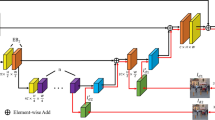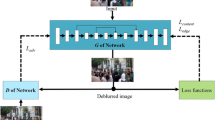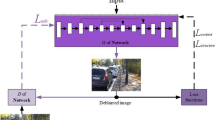Abstract
Not all pixels are appropriate for image deblurring by traditional image deblurring methods. Similarly, not all feature information is appropriate for network model learning. To extract feature information effectively and ensure that the network pays attention to the feature information that is conducive to image deblurring, a dense Do-conv residual network with multisupervision and mixed attention is proposed, which is called DDABNet. First, we construct the Do-CA-Conv residual block by focusing on the important channels at the convolution level and densely connect the Do-CA-Conv residual blocks by summation in the first half and concatenation in the second half to construct DoDense(S &C) block. Second, at the third-scale stage of the encoder and decoder, to build interdimensional dependencies in the DoDense(S &C) block, we rotate the feature cube along certain dimensions to obtain an attention map and rotate it back before the first and second Do-CA-Conv residual blocks. Third, after the DoDense(S &C) block, followed by adaptive mixed-channel attention and spatial attention, which enhance attention to important information, the DoDense(S &C) attention block(DDAB) is constructed. Finally, the encoder and decoder outputs are constrained with multisupervision in the frequency domain. A visual inspection and the objective evaluation index of the benchmark datasets show the effectiveness of our proposed network.









Similar content being viewed by others
Data Availability
The datasets generated or analysed during the current study are available from the corresponding author on reasonable request.
References
Ma L, Zhao F, Hong* H, Wang L, Zhu Y (2023) Complementary parts contrastive learning for fine-grained weakly supervised object co-localization. IEEE Trans Circuits Syst Video Technol 33(11): 6635–6648
Lei M, Xinyi L, Hanyu H, Yaozhong Z, Lei W, Jinmeng W (2022) Scribbleattention hierarchical network for weakly supervised salient object detection in optical remote sensing images. Appl Intell 53: 12999–13017
Ma L, Xu Q, Hong H, Shi Y, Zhu Y, Wang L (2023) Joint ordinal regression and multiclass classification for diabetic retinopathy grading with transformers and CNNs fusion network. Appl Intell 53:27505–27518
Abdullah A, Brown MS (2020) Defocus deblurring using dual-pixel data. European Conference on Computer Vision, pp 1–25
Cao J, Li Y, Sun M et al (2020) Do-conv: Depthwise over-parameterized convolutional layer. IEEE Trans Image Process 31:3726–3736
Cho SJ, Ji SW, Hong JP, et al (2021) Rethinking coarse-to-fine approach in single image deblurring. In: IEEE Conference on computer vision and pattern recognition, pp 4641–4650
Chollet F (2017) Xception: Deep learning with depthwise separable convolutions. In: IEEE Conference on computer vision and pattern recognition, pp 1251–1258
Chu X, Chen L, Chen C, et al (2021) Revisiting global statistics aggregation for improving image restoration. European Conference on Computer Vision, pp 53–71
Fergus R, Singh B, Hertzmann A et al (2006) Removing camera shake from a single photograph. ACM Trans Graph 25(3):787–794
Fu X, Huang J, Ding X et al (2017) Clearing the skies: A deep network architecture for single-image rain removal. IEEE Trans Image Process 26(6):2944–2956
Fu X, Huang J, Zeng D, et al (2017) Removing rain from single images via a deep detail network. In: IEEE Conference on computer vision pattern recognition, pp 1715–1723
Gao H, Tao X, Shen X, et al (2019) Dynamic scene deblurring with parameter selective sharing and nested skip connections. In: IEEE Conference on computer vision and pattern recognition, pp 3843–3851
He K, Zhang X, Ren S, et al (2016) Deep residual learning for image recognition. IEEE Conference on Computer Vision and Pattern Recognition, pp 770–778
He Z, Patel VM (2018) Density-aware single image de-raining using a multi-stream dense network. IEEE Conference on Computer Vision and Pattern Recognition, pp 695–704
Jiang K, Wang Z, Yi P, et al (2020) Multi-scale progressive fusion network for single image deraining. IEEE Conference on Computer Vision and Pattern Recognition, pp 8343–8352
Karaali A, Jung CR (2018) Edge-based defocus blur estimation with adaptive scale selection. IEEE Trans Image Process 27(3):1126–1137
Krishnan D, Tay T, Fergus R (2011) Blind deconvolution using a normalized sparsity measure. In: IEEE Conference on computer vision and pattern recognition, pp 2657–2664
Kupyn O, Budzan V, Mykhailych M, et al (2018) Deblurgan: Blind motion deblurring using conditional adversarial networks. IEEE Conference on Computer Vision and Pattern Recognition, pp 8183–8192
Kupyn O, Martyniuk T, Wu J, et al (2019) Deblurgan-v2: Deblurring (orders-of-magnitude) faster and better. In: IEEE Conference on computer vision and pattern recognition, pp 8878–8887
Lee J, Lee S, Cho S, et al (2019) Deep defocus map estimation using domain adaptation. In: IEEE Conference on computer vision and pattern recognition, pp 12214–12222
Lee J, Son H, Rim J, et al (2021) Iterative filter adaptive network for single image defocus deblurring. In: IEEE Conference on computer vision and pattern recognition, pp 2034–2042
Levin A, Weiss Y, Durand F, et al (2011) Efficient marginal likelihood optimization in blind deconvolution. In: IEEE Conference on computer vision and pattern recognition, pp 2657–2664
Li X, Zheng S, Jia J (2013) Unnatural l0 sparse representation for natural image deblurring. In: IEEE Conference on computer vision and pattern recognition, pp 1107–1114
Li X, Wu J, Lin Z, et al (2018) Recurrent squeeze-and-excitation context aggregation net for single image deraining. European Conference on Computer Vision, pp 262–277
Li X, Wang W, Hu X, et al (2020) Selective kernel networks. IEEE Conference on Computer Vision and Pattern Recognition, pp 510–519
Liang J, Cao J, Fan Y, et al (2022) Vrt: A video restoration transformer
Loshchilov I, Hutter F (2016) Sgdr: Stochastic gradient descent with warm restarts. In: International conference on learning representations, pp 1–9
Misra D, Nalamada T, Arasanipalai AU, et al (2020) Rotate to attend: Convolutional triplet attention module. IEEE Winter Conference on Applications of Computer Vision, pp 3138–3147
Nah S, Kim TH, Lee KM (2016) Deep multi-scale convolutional neural network for dynamic scene deblurring. IEEE Conference on Computer Vision and Pattern Recognition pp 3883–3891
Pan J, Sun D, Pfister H et al (2017) Deblurring images via dark channel prior. IEEE Trans Pattern Anal Mach Intell 40:2315–2328
Park D, Dong UK, Kim J, et al (2019) Multi-temporal recurrent neural networks for progressive non-uniform single image deblurring with incremental temporal training. European Conference on Computer Vision, pp 372–343
Qi S, Jia J, Agarwala A (2008) High-quality motion deblurring from a single image. ACM Trans Graph 27(3):1–10
Ren D, Zuo W, Hu Q, et al (2019) Progressive image deraining networks: A better and simpler baseline. IEEE Conference on Computer Vision and Pattern Recognition, pp 3932–3941
Shi J, Li X, Jia J (2015) Just noticeable defocus blur detection and estimation. In: IEEE Conference on computer vision and pattern recognition, pp 657–665
Sun L, Sakaridis C, Liang J, et al (2021) Event-based fusion for motion deblurring with cross-modal attention. In: European conference on computer vision, pp 412–428
Tao X, Gao H, Wang Y, et al (2018) Scale-recurrent network for deep image deblurring. In: IEEE Conference on computer vision and pattern recognition, pp 8174–8182
Wang Q, Wu B, Zhu P, et al (2020) Eca-net: Efficient channel attention for deep convolutional neural networks. In: IEEE Conference on computer vision and pattern recognition, pp 11531–11539
Wei W, Meng D, Zhao Q, et al (2020) Semi-supervised transfer learning for image rain removal. In: IEEE Conference on computer vision and pattern recognition, pp 3872–3881
Woo S, Park J, Lee YJ, et al (2018) Cbam:convolutional block attention. In: European conference on computer vision, pp 1–17
Xin Y, Feng X, Zhang S et al (2014) Efficient patch-wise non-uniform deblurring for a single image. IEEE Trans Multimed 16(6):1510–1524
Yang W, Tan RT, Feng J, et al (2017) Deep joint rain detection and removal from a single image. In: IEEE Conference on computer vision and pattern recognition, pp 1685–1694
Yasarla R, Patel VM (2019) Uncertainty guided multi-scale residual learning-using a cycle spinning cnn for single image de-raining. IEEE Conference on computer vision and pattern recognition, pp 8397–8406
Zamir SW, Arora A, Khan S, et al (2021) Multi-stage progressive image restoration. In: IEEE Conference on computer vision and pattern recognition, pp 14816–14826
Zamir SW, Arora A, Khan S et al (2022) Restormer: efficient transformer for high-resolution image restoration. IEEE conference on computer vision and pattern recognition, pp 5718–5729
Zhang H, Cisse M, Dauphin YN, et al (2017) mixup: Beyond empirical risk minimization. International Conference on Learning Representations, pp 1–13
Zhang H, Sindagi V, Patel VM (2017) Image de-raining using a conditional generative adversarial network. IEEE Trans Circ Syst Vid Technol 30(11):3943–3956
Zhang H, Dai Y, Li H, et al (2019) Deep stacked hierarchical multi-patch network for image deblurring. IEEE Conference on Computer Vision and Pattern Recognition, pp 5971–5979
Zhang J, Pan J, Ren J, et al (2018) Dynamic scene deblurring using spatially variant recurrent neural networks. In: IEEE Conference on Computer Vision and Pattern Recognition, pp 2521–2529
Zhang Y, Tian Y, Kong Y, et al (2021) Residual dense network for image restoration. In: IEEE Transactions on pattern analysis and machine intelligence, pp 2480–2495
Ma L, Hong H, Meng F, Wu Q, Wu J (2023) Deep progressive asymmetric quantization based on causal intervention for fine-grained image retrieval. IEEE Transactions on Multimedia, pp 1–13
Acknowledgements
This work was supported in part by the National Natural Science Foundation of China under Grants No.62201406 and No.62171329, and in part by the Guiding Scientific Research Project of Hubei Provincial Department of Education on No.B2021086.
Author information
Authors and Affiliations
Corresponding author
Ethics declarations
Conflicts of interest
The authors declare that they have no conflict of interest.
Additional information
Publisher's Note
Springer Nature remains neutral with regard to jurisdictional claims in published maps and institutional affiliations.
Rights and permissions
Springer Nature or its licensor (e.g. a society or other partner) holds exclusive rights to this article under a publishing agreement with the author(s) or other rightsholder(s); author self-archiving of the accepted manuscript version of this article is solely governed by the terms of such publishing agreement and applicable law.
About this article
Cite this article
Shi, Y., Huang, Z., Chen, J. et al. DDABNet: a dense Do-conv residual network with multisupervision and mixed attention for image deblurring. Appl Intell 53, 30911–30926 (2023). https://doi.org/10.1007/s10489-023-05122-1
Accepted:
Published:
Issue Date:
DOI: https://doi.org/10.1007/s10489-023-05122-1




